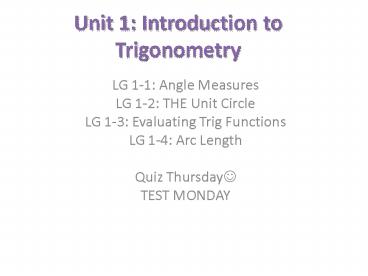Unit 1: Introduction to Trigonometry - PowerPoint PPT Presentation
1 / 15
Title:
Unit 1: Introduction to Trigonometry
Description:
Unit 1: Introduction to Trigonometry LG 1-1: Angle Measures LG 1-2: THE Unit Circle LG 1-3: Evaluating Trig Functions LG 1-4: Arc Length Quiz Thursday – PowerPoint PPT presentation
Number of Views:248
Avg rating:3.0/5.0
Title: Unit 1: Introduction to Trigonometry
1
Unit 1 Introduction to Trigonometry
- LG 1-1 Angle Measures
- LG 1-2 THE Unit Circle
- LG 1-3 Evaluating Trig Functions
- LG 1-4 Arc Length
- Quiz Thursday?
- TEST MONDAY
2
Consider a circle, centered at the origin with 2
rays extending from the center.
One ray is fixed along the positive x-axis
The other can rotate about the center
- These rays form an angle. The fixed ray is called
the initial side of the angle. - The other side is called the terminal side.
- Any angle with vertex at the origin and initial
side along the positive x-axis is in standard
position.
3
As the terminal side is rotated counterclockwise,
the measure of the angle that is formed
increases.
30o
135o
210o
4
The rotation of the terminal side may include 1
or more complete revolutions about the center.
The measurement representing 1 complete
revolution is 360o
1 revolution 360o
2 revolutions 720o
1 revolution 60o 420o
5
Angles that differ by one or more complete
revolutions are called coterminal angles.
- For example 74o, 434o, and 794o are all
coterminal angles. Why? - Think of at least 2 coterminal angles for 105o
6
The terminal side of an angle can also rotate
clockwise. A negative number is used to denote
these angle measures.
-45o
-150o
-420o
7
Suppose the angles on your cards are in standard
position. Place each angle in the quadrant that
contains its terminal side.
245o 275o 440o -94o
397o -240o 198o 945o
800o -32o 300o -210o
8
Suppose the angles on your cards are in standard
position. Place each angle in the quadrant that
contains its terminal side.
9
90o
-240o
397o
-210o
800o
440o
First, label the points where the circle
intersects the axes.
How would these angles change if they opened
clockwise?
180o
0o
360o
245o
-32o
198o
-94o
300o
275o
945o
270o
10
How do bulldogs get flat noses?
- Complete the activity in the next 10 minutes. You
may work with a partner (so you dont have to
keep flipping!)
11
A unit other than degrees is also used to
describe the measure of an angle. It is called
the radian.
- Suppose there is a circle with radius of 1
centered at the origin. Its called the Unit
Circle - Form an angle in standard position so that it
intercepts an arc whose length is one unit. - The angle made is given the measurement of 1
radian.
Approximately 6.28 of these slices can fit all
the way around the circle
12
- You will convert degrees to radians and vice
versa by using this conversion
13
Examples
- Convert the following to degrees
- B. Convert the following to radians
- C. Determine which quadrant each of the above
angles is located.
14
Practice
15
Ticket out the Door
- On a half sheet of paper, describe in words what
a coterminal angle is. How do you find a
coterminal angle?
16
Homework
- Complete the worksheet































